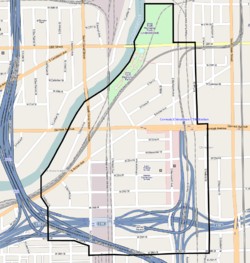

It is not to be confused with an area sometimes called "New Chinatown", which is on the North Side around Argyle Street, and which attracts a larger number of people of Southeast Asian heritage.
History
In the 1920s, Chinese community leaders secured approximately 50 ten-year leases on properties in the newly developing Chinatown. Because of severe racial discrimination, these leases needed to be secured via an intermediary, H. O. Stone Company. Jim Moy, then-director of the On Leong Merchants Association, then decided that a Chinese-style building should be constructed as a strong visual announcement of the Chinese community's new presence in the area. With no Chinese-born architects in Chicago at the time, Chicago-born Norse architects Christian S. Michaelsen and Sigurd A. Rognstad were asked to design the new On Leong Merchants Association Building in spring, 1926. After studying texts on Chinese architecture, Michaelsen and Rognstad's final design was an example of Orientalism, a Western architect's interpretation of Chinese architectural forms. When the building opened in 1928 at a cost of a million dollars, it was the finest large Chinese-style structure in any North American Chinatown. The On Leong Association allowed the Chinese Consolidated Benevolent Association to put its headquarters in the new building and also used it as an immigrant assistance center, a school, a shrine, a meeting hall, and office space for the Association itself. It was often informally referred to as Chinatown's "city hall." Michaelsen and Rognstad designed two other Chinese-inspired buildings that were built in the area in 1928—Won Kow Restaurant, Chinatown's oldest restaurant, and the Moy Shee D.K Association Building, the former receiving a two-story addition in 1932.
During the late 1980s, a group of Chinatown business leaders bought 32 acres (130,000 m2) property north of Archer Avenue from the Santa Fe Railway and builtChinatown Square, a two-level mall consisting of restaurants, beauty salons and law offices, flanked by 21 new townhouses. Additional residential construction, such as the Santa Fe Gardens, a 600-unit village of townhouses, condominiums and single-family homes still under construction on formerly industrial land to the north. Perhaps the most outstanding feature of the new addition was the creation of Ping Tom Memorial Park in 1999; located on the bank of the Chicago River, the park features a Chinese-style pavilion that many consider to be the most beautiful in the Midwest.
Commerce
Chicago's Chinatown is home to a number of banks, Chinese restaurants, gift shops, grocery stores, Chinese medicinestores, as well as a number of services that cater to people interested in Chinese culture, including those speakingChinese, especially the Cantonese dialect. It is a community hub for Chinese people in Chicago metropolitan area, a business center for Chinese in the Midwest, as well as a popular destination for tourists and locals alike.



















